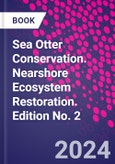Sea Otter Conservation: Nearshore Ecosystem Restoration, Second Edition offers the most updated and revised ecological knowledge for conserving sea otters and their coastal habitats. As sea otters are good indicators of ocean health, they are also keystone species, offering a stabilizing effect on ecosystems, controlling sea urchin populations that can damage kelp forests, and curbing coastal erosion. This book synthesizes the important relationship between sea otters and conservation of themselves as well as vital marine ecosystems. Written by experts in the field, this book contains two sections that focus first on the latest data, practices, and hands-on research for conserving coastal ecosystems. Sections offer links between sea otter presence and increased kelp, seagrass, and geological conservation, while also focusing specifically on the sea otter and providing up-to-date research, data, and case studies regarding their genetics, habitats, and impacts of climate change.
Table of Contents
Part I: Nearshore Ecosystem Restoration 1. Introduction 2. Kelp-urchin-otter paradigm direct and indirect effects of sea otter presence 3. Seagrass and estuary community restoration and sea otter interactions 4. Soft sediment community restoration and the role of sea otters 5. Human perspectives of coastal ecosystems 6. Linkages between nearshore and coastal terrestrial ecosystems 7. Coastal marine ecosystem functioning gains and losses of the fur trade Part II: Species Conservation 8. The history of sea otter conservation 9. Why space is so important case studies of Glacier Bay, Southeast Alaska, and the Aleutian chain 10. Nearshore study 11. New genetics research 12. Sea otters and climate change 13. Future reintroductions and restoring nearshore ecosystems








